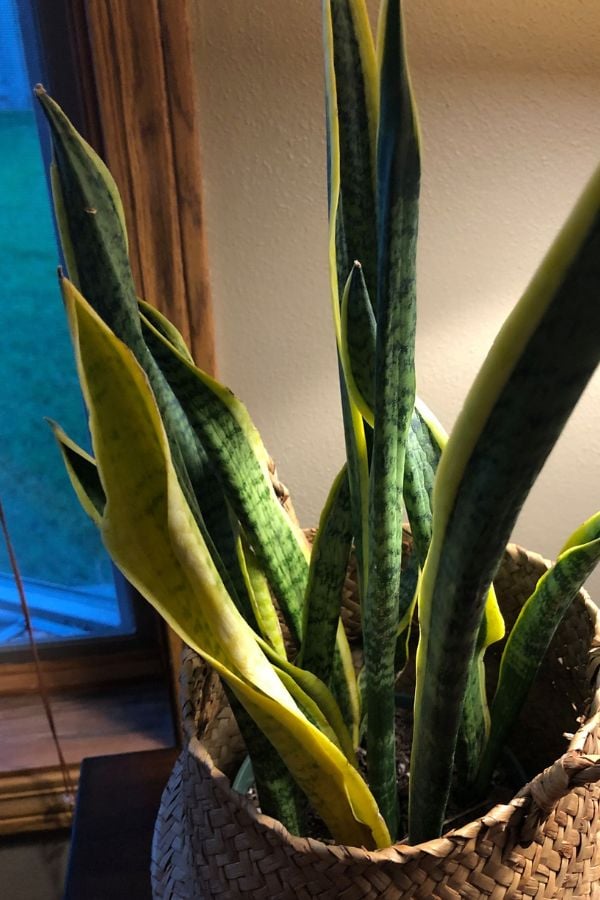Have you ever noticed that your snake plant, which was perfectly straight when you bought it, has somehow become twisted and looks a bit disheveled? Wondering what to do?
Today, I’m here to address your concerns about your snake plant’s twisting leaves.
After reading this article, you’ll understand:
- The main reasons why snake plants twist
- How to deal with a twisting snake plant
- Preventative measures for twisted leaves in snake plants
Contents
- So, What Causes a Snake Plant to Twist or Curl?
- Can Twisted Snake Plant Leaves Be Restored to Their Original State?
- Twisting Tendencies in the Center of the Plant
- How to Deal with a Twisted Snake Plant?
- Preventing Your Snake Plant from Twisting: Essential Tips!
- Summary: Understanding and Preventing Twisting in Snake Plants
So, What Causes a Snake Plant to Twist or Curl?
The primary cause of twisting in snake plants is inadequate light. Plants have a characteristic called “phototropism,” which is directly related to the twisting of snake plant leaves.
Phototropism is the tendency of a plant to change the direction of its leaves or flowers towards sunlight.
Although snake plants are known for their shade tolerance and are popular as indoor ornamental plants, they are inherently sun-loving.
If you keep them indoors for prolonged periods, they might not get enough sunlight, causing their leaves to seek light in various directions. This quest for light can result in the leaves twisting.
Can Twisted Snake Plant Leaves Be Restored to Their Original State?
Unfortunately, it’s tough to revert already twisted leaves back to their original straight form. I know it’s a bit disappointing, especially since twisted leaves tend to detract from the plant’s aesthetic appeal.
Twisting Tendencies in the Center of the Plant
Based on my experience in growing Sansevieria, I’ve noticed that the leaves in the center of the plant are particularly prone to twisting. Take a look at the photo below.

You can see that the leaves of this snake plant are twisted overall. Not only that, but each leaf appears somewhat frail and weak.
This particular twisted Sansevieria in the photo was created by gathering leaves from the center of the parent plant during division. The second photo shows the snake plant before division.
The leaves in the center part tend to twist more often because they receive less sunlight compared to the outer leaves.
When leaves in less sun-exposed areas don’t get enough light, they start turning in various directions, leading to more twisting.
How to Deal with a Twisted Snake Plant?
Now, what to do if your snake plant has already twisted. I know it’s a bit of a bummer that twisted snake plant leaves can’t easily be restored to their original straight form. But don’t worry, there are still things we can try!
Dealing with a Twisted Snake Plant Starts with Sunlight and Good Air Circulation
For a twisted leaf, try tying it gently with hemp cord or a ribbon and keep it in a warm, sunny place.
It might take some time, but the weakened, twisted leaves can regain their strength and stand up on their own. (See the image below.) In about a year, the leaves that were weak and limp can regain their turgidity.

Ensuring sufficient air circulation and sunlight can help the plant to stand upright again. A well-nourished plant might even start flowering, as seen in the upper image.
But What About Those Twisted Leaves?
I get it, sometimes you just can’t stand looking at those twisted leaves. In that case, I suggest cutting the twisted leaves near their base and waiting for new offshoots to emerge.
Cut the twisted leaves around April to June, and with some luck, new shoots should appear from the base in a few months.
Then, make sure to place it in a sunny spot (above 60°F or 15°C, outdoor is best) to prevent sunlight deficiency. Keep in mind, if you grow it in the same conditions, there’s a risk of the leaves twisting again.
What About Using Cut Leaves for Propagation?
You can also use the cut, twisted leaves for propagation through leaf cuttings. With some patience, you might see new offshoots in about a year. (Check out the photo below.)

However, be aware that leaf propagation takes time, and if you’re dealing with a variegated variety, the new plants might revert to the original green form. This is known as “reversion.”
For example, with the variegated ‘Sansevieria Laurentii’ which has green leaves with yellow edges, the new plants from leaf cuttings are likely to be the original green Sansevieria without the yellow-edged pattern.
About two years after leaf propagation, the new Sansevieria plants typically revert to the non-variegated original species.
Preventing Your Snake Plant from Twisting: Essential Tips!
Alright, now that we know the main causes of twisting in snake plants, let’s dive into how to prevent it. I’ve got some great tips to share with you!
Preventive Measure #1: Ensure Ample Sunlight
First things first, snake plants absolutely love sunlight. Although they’re popular as indoor plants due to their shade tolerance, they really thrive in bright, well-ventilated areas.
If you want to grow sturdy, twist-free leaves, the best spot indoors would be near south- to east-facing windows.
But what if you can’t find a sunny enough spot? I’ve got a solution – using a “Plant Growth LED Light.”
I understand that it’s not always easy to find a sunny spot, especially if you tend to keep curtains closed for security reasons. In such cases, a plant growth LED light can be a lifesaver.
These lights emit a spectrum similar to sunlight and can compensate for the lack of natural light in darker rooms.
There are various types of LED grow lights, like stand, clip-on, or hanging types. You’ll need to choose one that suits your environment and your plant’s needs.
Preventive Measure #2: Ensure Good Air Circulation
Another key factor for healthy plant growth is air circulation, along with light and water. Snake plants particularly dislike stuffy conditions.
Keeping them in well-ventilated areas not only strengthens the leaves but also helps prevent root rot and pests.
If the temperature stays above 60°F (15°C), I recommend outdoor care. Keeping an eye on the weather forecast, place your snake plant outside when the temperature is favorable.
Keep it under an eave to protect it from rain, and water it when the soil is thoroughly dry. While indoor care can’t match the airflow of outdoor care, if you do move your plant outside, take a few days to gradually acclimate it to the sunlight.
Snake plants have this amazing ability to absorb carbon dioxide and release oxygen at night. Growing them in an area with good air circulation enhances their oxygen supply, promoting healthier growth.
Preventive Measure #3 for Snake Plants: Rotate Regularly
Another simple yet effective tip to prevent twisting in your snake plant – regular rotation.
As I mentioned earlier, plants exhibit a characteristic called “phototropism,” where they grow towards light sources.
If your plant sits in the same position for too long, it will stretch its branches and stems only towards the light (usually a window), leading to twisted and disheveled growth.
Make Rotation a Habit During Watering
Regularly changing the direction of your indoor plants is not only good for their health but also helps maintain their appearance.
To keep your snake plant looking beautiful and prevent leaf twisting, I recommend rotating it once every week to a month.
A handy trick is to make this a habit every time you water your plant. It’s an easy way to remember, and it’ll do wonders for your plant’s health and aesthetics. Give it a try and make it part of your routine!
Summary: Understanding and Preventing Twisting in Snake Plants
In this article, I’ve shared with you the main reasons why snake plants twist and some measures to prevent this issue.
There are several theories about why snake plants twist. Besides insufficient light, other possible causes include lack of water and poor air circulation leading to stunted growth.
Personally, I believe that one of the best ways to grow a healthy, well-shaped snake plant is to keep it outdoors when temperatures are above 60°F (15°C).
The key to growing straight, twist-free snake plants is ensuring they get plenty of sunlight and air circulation. Here’s a quick recap:
Main Causes and Remedies for Twisting in Snake Plants:
- Lack of sunlight
- Poor air circulation
- Water deficiency
It’s difficult to revert already twisted leaves. Consider cutting twisted leaves from the base and wait for new offshoots, or use the cut leaves for propagation.
Tips to Prevent Twisting:
- From spring to fall, when the temperature is above 60°F (15°C), keep the plant outdoors to ensure it gets enough sunlight and air circulation. Water only when the soil is completely dry.
- When temperatures drop below 60°F (15°C), move it indoors. During winter, water the plant only when the leaves start to wrinkle. It’s essential to avoid overwatering as snake plants are prone to root rot in humid conditions. Generally, it’s best to keep the soil on the drier side.






